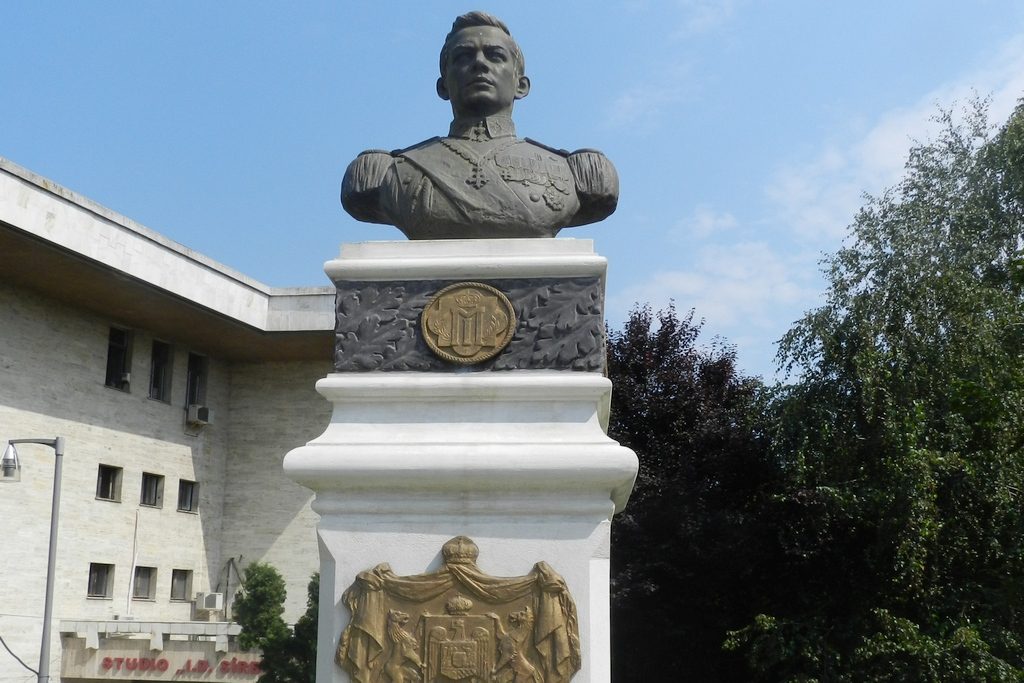

The bust was executed by the sculptor from Craiova Marcel Voinea and it was unveiled in the year 2014, in the presence of the authorities and of the common citizens from Craiova.
Michael I (born on the 25th of October 1921, Sinaia) was the king of Romania between the 20th of July 1927 and the 8th of June 1930, as well as between the 6th of September 1940 and the 30th of December 1947. Son of the inherited prince Carol, Michael inherited from the birth the titles of prince of Romania and prince of Hohenzollern – Sigmaringen (at which he gave up later).
Michael became for the first time king of Romania in 1927, after the death of his grandfather Ferdinand, because of the fact that his father gave up in December 1925 the throne and remained abroad. Being minor, the royal attributions were fulfilled by regency, which didn’t rise at the level of the problems of the political life, the sudden and illegal return of June 1930 of Carol not facing any kind of resistance.
In September 1939, started the Second World War, and the year 1940 market the end of the Greater Romania, which lost without a fight, in a few months, Bessarabia, the North of Bucovina, Herța, the Nord-West Transylvania and the Quadrangular. On the 6th of September 1940, Carol the IInd was obligated by the new prime-minister, the general Ion Antonescu, to abdicate and to leave the country, the throne coming back to Michael. He wasn’t previously informed about the entering of Romania in war together with the Nazi Germany.
When the balance of the war was back and the soviet forces entered in the territory of Romania, king Michael decided to save what could be saved and he executed the coup d’etat of the 23rd of August 1944: the arrest of Antonescu and the restoration of the Constitution of 1923. The soviet union postponed the signing of a truce in September 1944 until he occupied the entire country, starting with the process of imposing his political system over the new satellite. Lacking the support of the Great Britain and of the United States of America, with the situation of Transylvania as means of blackmail of the Russians, the king was obligated that in February 1945 to name as prime-minister the anti-communist Nicolae Rădescu and to name Petru Groza at the government, who proved to be a docile instrument in the hands of the communist. In a sign of protest towards the abuses of the new government, the king entered into the so-called “Royal strike”, refusing to sign the decrees of the government, but who followed unhindered the un-constitutional activity.
On the 30th of December 1947, the king was compelled to sign the abdication decree, in the same time being proclaimed as Popular Republic.
In January he left in exile, where he tried to plead for the cause of his country, but he hit a wall of dullness. He got married with the princess Ana de Bourbon – Parma and they settled after many peregrinations at Versois, in Switzerland. The couple has five daughters, the princesses Margareta, Elena, Irina, Sofia and Maria. After the Revolution of 1989, he was stopped by the regime of Ion Iliescu to come back in the country, with the exception of the Easter from 1992, when he attracted enthusiast crowds who came to see him. Only under the presidency of Emil Constantinescu, in 1997, he received back his Romanian citizenship. Further on, he was given back also a part of the properties. Under the occasion of his 90th birthday, on the 25th of October 2011, Michael delivered a speech in front of the reunited chambers of the Romanian Parliament. In March 2016, it was announced his outbreak of cancer and his retiring from the public life.
